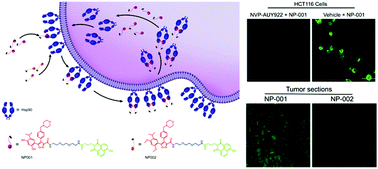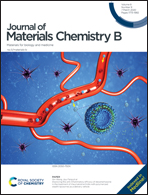Optimized HSP90 mediated fluorescent probes for cancer-specific bioimaging†
Abstract
Cancer-specific bioimaging has been correlated with fluorescence-guided tumor therapy, garnering extensive interest from researchers. Herein, a highly efficient tumor-targeting fluorescent probe (NP-001), which is integrated with 4-hydroxy-1,8-naphthalimide and NVP-AUY922, for tumor imaging has been established. 4-Hydroxy-1,8-naphthalimide is a fluorescent molecule with remarkable imaging compatibility. NVP-AUY922 is a heat shock protein 90 (HSP90) inhibitor with preferential tumor selectivity that is conjugated to 4-hydroxy-1,8-naphthalimide as a tumor-targeting ligand. NP-002, a resorcinol-blocked probe which prevented binding with an amino acid residue of the HSP90 ATP binding pocket, was also synthesized as a control. In vitro and ex vivo assays showed that NP-001 could arrest cell proliferation, induce apoptosis and accumulate to inhibit HSP90. Confocal laser scanning microscopy (CLSM) also confirmed that NP-001 could be selectively internalized by tumor cells for cancer-specific bioimaging. Moreover, pharmacokinetic studies and histological analysis also indicated that NP-001 had a relatively longer retention time and showed no major organ-related toxicities. Overall, these encouraging data suggest that NP-001 is a promising new candidate for the early diagnosis of metastatic disease as well as targeted tumor imaging.



 Please wait while we load your content...
Please wait while we load your content...